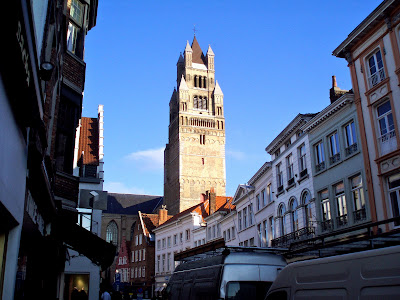Windmill Chasing on a Chilly But Sunny Day
The second major church tower in Brugge belongs to St. Saviour's Cathedral. This is the oldest parish church in Bruges. While this tower is not covered, the interior of this church is undergoing major refurbishment. There were architects and engineers working inside the cathedral while we toured it. I got to watch them as they were scoured the ceiling with their mega power LED flashlights carefully inspecting then making notations on their field drawings.
Yesterday we took a long walk viewing Brugge's superb medieval gothic architecture, its 3 major towers (two are part of major churches and one is the belfry on the Grand Place), and its very picturesque canals.
Our visit disclosed that (like seemingly everything else in Brugge,) its churches are undergoing major refurbishment. This is a good thing as the historic town of Brugge has been designated a UNESCO World Heritage site and is deserving of great care.
Brugge dates back to the 12th century. By 1420 its strategic location made it a magnet for residents from all over the continent and one of Europe's major economic capitals. This was reinforced when the Duke of Burgundy, Phillipe le Bon, (known as "Phillipe The Good") made it a center of court life and became a patron of Flemish artists including Brugge's Jan van Eyck.
By 1500 when the discovery of America shifted the economic energy of Europe from the Atlantic to the Mediterranean Brugge entered in a period of decline (similar to Amsterdam.) With the development of canals between 1600 to 1800 Brugge modestly re-established its maritime connections and again prospered.
Brugge has been controlled by the French, the English, the Hapsburg's, and the Netherlands. It did not become part of Belgium until 1830.
So, back to the towers! In the case of the churches, once you are inside the churches, there are no visible connections to suggest the immense towers above. The tower of the Church of Our Lady is over 400' tall and is the tallest structure in Brugge. In fact its tower is the second tallest brick structure in the world. During our visit it was covered up with scaffolding and tyvek.
Our visit disclosed that (like seemingly everything else in Brugge,) its churches are undergoing major refurbishment. This is a good thing as the historic town of Brugge has been designated a UNESCO World Heritage site and is deserving of great care.
Brugge dates back to the 12th century. By 1420 its strategic location made it a magnet for residents from all over the continent and one of Europe's major economic capitals. This was reinforced when the Duke of Burgundy, Phillipe le Bon, (known as "Phillipe The Good") made it a center of court life and became a patron of Flemish artists including Brugge's Jan van Eyck.
By 1500 when the discovery of America shifted the economic energy of Europe from the Atlantic to the Mediterranean Brugge entered in a period of decline (similar to Amsterdam.) With the development of canals between 1600 to 1800 Brugge modestly re-established its maritime connections and again prospered.
Brugge has been controlled by the French, the English, the Hapsburg's, and the Netherlands. It did not become part of Belgium until 1830.
So, back to the towers! In the case of the churches, once you are inside the churches, there are no visible connections to suggest the immense towers above. The tower of the Church of Our Lady is over 400' tall and is the tallest structure in Brugge. In fact its tower is the second tallest brick structure in the world. During our visit it was covered up with scaffolding and tyvek.
The Interior of the Church of Our Lady
The interior of the Church of Our Lady contains a sculpture by Michelangelo. It is one of the few pieces by Michelangelo outside of Italy. It has been looted twice, once by the French and again by the Nazi's. Luckily it has been recovered each time.
The second major church tower in Brugge belongs to St. Saviour's Cathedral. This is the oldest parish church in Bruges. While this tower is not covered, the interior of this church is undergoing major refurbishment. There were architects and engineers working inside the cathedral while we toured it. I got to watch them as they were scoured the ceiling with their mega power LED flashlights carefully inspecting then making notations on their field drawings.
The Tower of St. Saviour's
The Spectacular Pipe Organ of St. Savior's
Clearly Brugge gets its construction work done in winter. In fact there are cranes seemingly all over Brugge. We awakened to jackhammers two days running.
The last major tower in Brugge is not connected with a church - it is the town belfry on the Grand Place (Market Square.) This is the tower you can climb if you want to see the view. We opted not to climb the nearly 400 narrow freezing cold little steps in the tower.
The Brugge Belfry Used in the Movie "In Bruges"
Today (Thursday) was an easy laid back day. We walked to the edge of Brugge to two of its windmills. In the evening we enjoyed a very fine dinner (rack of lamb for me, scampi fettucine for Miss M).
Tomorrow we get up at 5 AM for our Thalys high speed train ride back to Paris. The balance of Friday is for exploring the Left Bank. Saturday is set aside for our trip to the Comic Art Exposition in Angouleme.
Roadboy's Travels © 2011





No comments:
Post a Comment